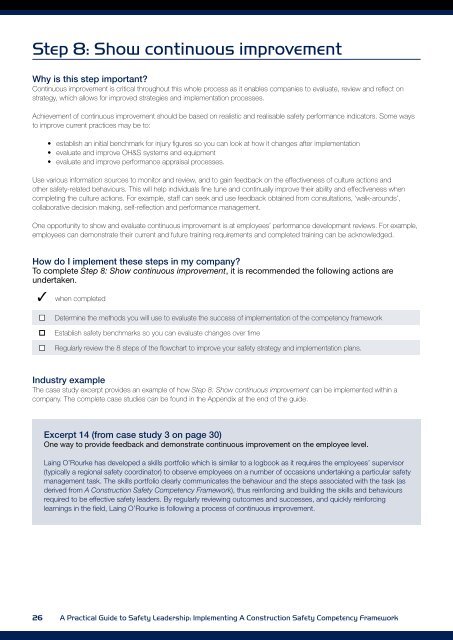A Practical Guide to Safety Leadership Book (PDF 5MB) - QUT ePrints
A Practical Guide to Safety Leadership Book (PDF 5MB) - QUT ePrints
A Practical Guide to Safety Leadership Book (PDF 5MB) - QUT ePrints
You also want an ePaper? Increase the reach of your titles
YUMPU automatically turns print PDFs into web optimized ePapers that Google loves.
Step 8: Show continuous improvement<br />
Why is this step important?<br />
Continuous improvement is critical throughout this whole process as it enables companies <strong>to</strong> evaluate, review and reflect on<br />
strategy, which allows for improved strategies and implementation processes.<br />
Achievement of continuous improvement should be based on realistic and realisable safety performance indica<strong>to</strong>rs. Some ways<br />
<strong>to</strong> improve current practices may be <strong>to</strong>:<br />
• establish an initial benchmark for injury figures so you can look at how it changes after implementation<br />
• evaluate and improve OH&S systems and equipment<br />
• evaluate and improve performance appraisal processes.<br />
Use various information sources <strong>to</strong> moni<strong>to</strong>r and review, and <strong>to</strong> gain feedback on the effectiveness of culture actions and<br />
other safety-related behaviours. This will help individuals fine tune and continually improve their ability and effectiveness when<br />
completing the culture actions. For example, staff can seek and use feedback obtained from consultations, ‘walk-arounds’,<br />
collaborative decision making, self-reflection and performance management.<br />
One opportunity <strong>to</strong> show and evaluate continuous improvement is at employees’ performance development reviews. For example,<br />
employees can demonstrate their current and future training requirements and completed training can be acknowledged.<br />
How do I implement these steps in my company?<br />
To complete Step 8: Show continuous improvement, it is recommended the following actions are<br />
undertaken.<br />
when completed<br />
■<br />
Determine the methods you will use <strong>to</strong> evaluate the success of implementation of the competency framework<br />
Establish safety benchmarks so you can evaluate changes over time<br />
■<br />
Regularly review the 8 steps of the flowchart <strong>to</strong> improve your safety strategy and implementation plans.<br />
Industry example<br />
The case study excerpt provides an example of how Step 8: Show continuous improvement can be implemented within a<br />
company. The complete case studies can be found in the Appendix at the end of the guide.<br />
Excerpt 14 (from case study 3 on page 30)<br />
One way <strong>to</strong> provide feedback and demonstrate continuous improvement on the employee level.<br />
Laing O’Rourke has developed a skills portfolio which is similar <strong>to</strong> a logbook as it requires the employees’ supervisor<br />
(typically a regional safety coordina<strong>to</strong>r) <strong>to</strong> observe employees on a number of occasions undertaking a particular safety<br />
management task. The skills portfolio clearly communicates the behaviour and the steps associated with the task (as<br />
derived from A Construction <strong>Safety</strong> Competency Framework), thus reinforcing and building the skills and behaviours<br />
required <strong>to</strong> be effective safety leaders. By regularly reviewing outcomes and successes, and quickly reinforcing<br />
learnings in the field, Laing O’Rourke is following a process of continuous improvement.<br />
26 A <strong>Practical</strong> <strong>Guide</strong> <strong>to</strong> <strong>Safety</strong> <strong>Leadership</strong>: Implementing A Construction <strong>Safety</strong> Competency Framework

















